
The rock dove, rock pigeon, or common pigeon is a member of the bird family Columbidae. In common usage, it is often simply referred to as the "pigeon", although this is the wild form of the bird; the pigeons most familiar to people are the domesticated form of the wild rock dove.
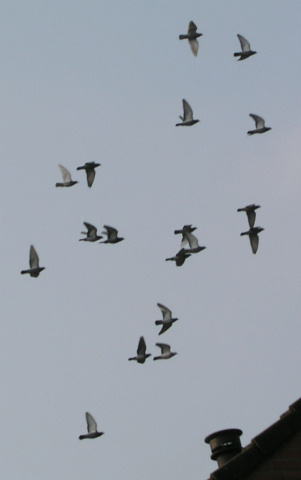
Pigeon racing is the sport of releasing specially trained homing pigeons, which then return to their homes over a carefully measured distance. The time it takes the animal to cover the specified distance is measured and the bird's rate of travel is calculated and compared with all of the other pigeons in the race to determine which animal returned at the highest speed.
Fancy pigeon refers to any breed of domestic pigeon, which is a domesticated form of the wild rock dove. They are bred by pigeon fanciers for various traits relating to size, shape, color, and behavior, and often exhibited at pigeon shows, fairs and other livestock exhibits.
The tippler is a breed of domestic pigeon bred to participate in endurance competitions. Flying results of up to 22 hours (non-stop) have been reported.

The domestic pigeon is a pigeon subspecies that was derived from the rock dove or rock pigeon. The rock pigeon is the world's oldest domesticated bird. Mesopotamian cuneiform tablets mention the domestication of pigeons more than 5,000 years ago, as do Egyptian hieroglyphics. Research suggests that domestication of pigeons occurred as early as 10,000 years ago.
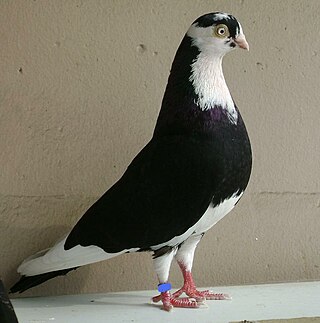
The Galatz Roller or Galați Roller is a domesticated pigeon breed originating in Galați County, Romania. Because these pigeons perform air acrobatics when they fly, they became very popular among pigeon fanciers in both the country of origin and the rest of Europe, especially in Germany, the Netherlands and Belgium. The air acrobatics that these Galați Roller birds perform are comparable to those of the Oriental Roller and Birmingham Roller pigeons.
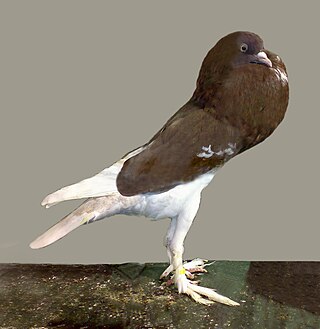
The English Pouter is a breed of fancy pigeon developed over many years of selective breeding. English Pouters, along with other varieties of domesticated pigeons, are all descendants from the rock pigeon. A breed with an enlarged crop, their distinctiveness was described by Charles Darwin in The Variation of Animals and Plants Under Domestication (1868).

The African Owl is a breed of fancy pigeon developed over many years of selective breeding. They originated in Tunisia (Africa), and were imported into England during the 19th century. The breed is known for its short beak, which gives the breed the "Owl" name due to the size and shape.

The Birmingham Roller is a breed of domesticated roller pigeon that originated in Birmingham, England. They were developed via selective breeding, for their ability to do rapid backward somersaults while flying.

The Komorn Tumbler is a breed of fancy pigeon developed over many years of selective breeding. The breed has American and European varieties that are recognized as separate breeds at shows with classes catering for American Komorner Tumblers and European Komorner Tumblers. Originally bred for acrobatic flying as a tumbler pigeon, Komorners are seldom free-flown today, and exist only for exhibition in pigeon shows.

The Egyptian Swift is a breed of fancy pigeon developed over many years of selective breeding. The name swift was given by reason of a resemblance to the bird of that name. Egyptian Swifts, along with other varieties of domesticated pigeons, are all descendants from the rock pigeon. The breed is known for its long wings and tail and its short beak. The flying Egyptian Swift is one or two inches shorter than a show Egyptian Swift.

The Jacobin is a breed of fancy pigeon developed over many years of selective breeding that originated in Asia. Jacobins, along with other varieties of domesticated pigeons, are all descendants of the rock pigeon. It is in the Asian feather and voice pigeon show group. The breed is known for its feathered hood over its head.

In culinary terminology, squab is an immature domestic pigeon, typically under four weeks old, or its meat. Some authors describe it as tasting like dark chicken.
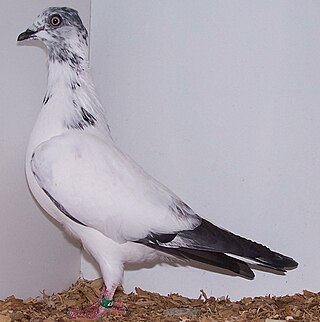
Flying/Sporting is the name of one of three main groupings of breeds of domesticated pigeons used by pigeon fanciers in the United States. The other two are Fancy and Utility.

Utility pigeons are domesticated pigeons bred to be a source of meat called squab. Squabs have been used as a food in many nations for centuries. They were bred to breed and grow quickly. Because they are bred for squab production, conformation to a show standard is usually deemed unimportant.
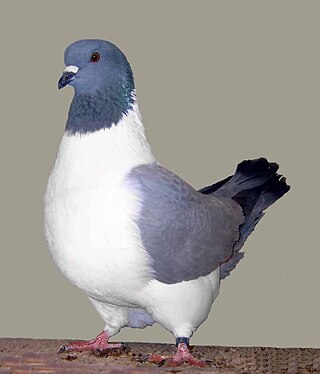
The Strasser is a breed of fancy pigeon developed over many years of selective breeding. Strassers, along with other varieties of domesticated pigeons, are all descendants from the rock pigeon . Apart from exhibition at pigeon shows, the breed is also used for utility purposes for producing squabs as food.
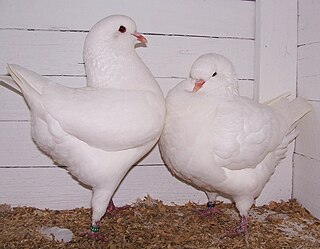
The King pigeon is a breed of pigeon developed over many years of selective breeding primarily as a utility breed. Kings along with other varieties of domesticated pigeons are all descendants from the rock dove.

The Carneau is a breed of pigeon developed over many years of selective breeding primarily as a utility pigeon. Carneau, along with other varieties of domesticated pigeons, are all descendants from the rock pigeon . The breed is known for large size and suitability for squab production. White Carneau pigeons are extensively used in experiments on operant conditioning; most of the pigeons used in B. F. Skinner's original work on schedules of reinforcement were White Carneaux.
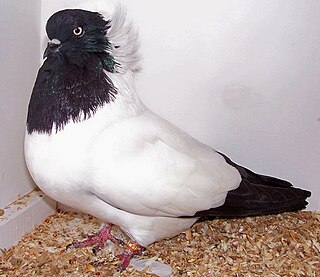
The Nun is a breed of fancy pigeon developed through many years of selective breeding. It was known as the Dutch Shell Pigeon in continental Europe. Nuns, along with other varieties of domesticated pigeons, are all descendants from the rock pigeon . The Nun is one of the oldest breeds and was originally a flying tumbler before being developed for exhibition. It is a mostly white breed, with a hood of feathers, which gives the name to the breed.
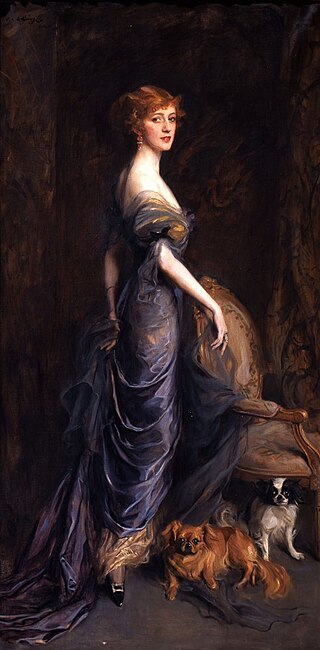
Animal fancy is a hobby involving the appreciation, promotion, or breeding of pet or domestic animals.























